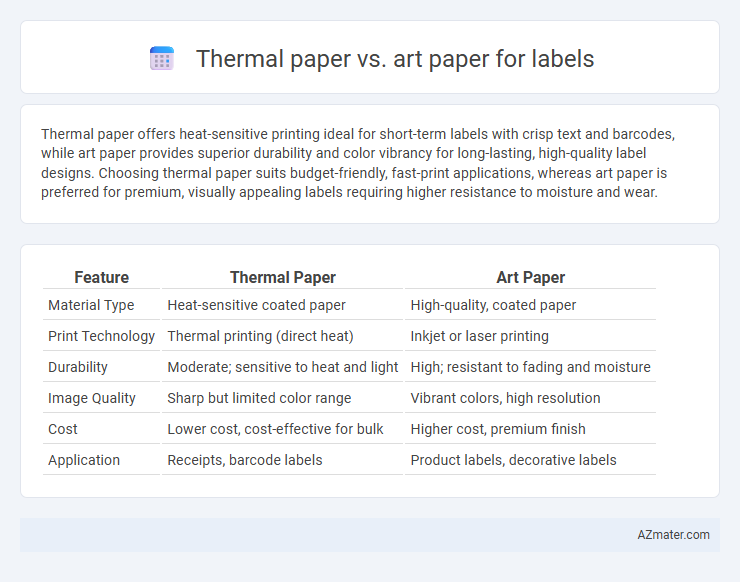Thermal paper offers heat-sensitive printing ideal for short-term labels with crisp text and barcodes, while art paper provides superior durability and color vibrancy for long-lasting, high-quality label designs. Choosing thermal paper suits budget-friendly, fast-print applications, whereas art paper is preferred for premium, visually appealing labels requiring higher resistance to moisture and wear.
Table of Comparison
| Feature | Thermal Paper | Art Paper |
|---|---|---|
| Material Type | Heat-sensitive coated paper | High-quality, coated paper |
| Print Technology | Thermal printing (direct heat) | Inkjet or laser printing |
| Durability | Moderate; sensitive to heat and light | High; resistant to fading and moisture |
| Image Quality | Sharp but limited color range | Vibrant colors, high resolution |
| Cost | Lower cost, cost-effective for bulk | Higher cost, premium finish |
| Application | Receipts, barcode labels | Product labels, decorative labels |
Introduction to Label Paper Types
Thermal paper for labels features a heat-sensitive coating that reacts to thermal printheads, offering fast, cost-effective, and smudge-resistant printing ideal for receipts and temporary labels. Art paper, characterized by its smooth, glossy finish and high-quality coating, provides vibrant color reproduction and durability, making it suitable for premium product labels and branding. Choosing between thermal and art paper depends on the label's purpose, print technology, and desired visual impact.
What is Thermal Paper?
Thermal paper is a specialized heat-sensitive paper coated with a chemical that changes color when exposed to heat, eliminating the need for ink or toner in printing labels. It is commonly used in label printing for products, receipts, and shipping due to its fast printing capability and high durability in short-term applications. Compared to art paper, thermal paper offers cost efficiency and quick print speeds but lacks the high-quality finish and long-term resistance found in art paper labels.
What is Art Paper?
Art paper is a high-quality coated paper commonly used for labels due to its smooth surface and excellent printability, enabling vibrant colors and sharp images. It is typically made from wood pulp with a clay or polymer coating that enhances durability and resistance to moisture and smudging. Unlike thermal paper, which relies on heat-sensitive chemicals for printing, art paper supports various printing methods such as offset, digital, and screen printing, making it ideal for premium, long-lasting labels.
Printing Technologies for Thermal and Art Paper
Thermal paper utilizes heat-sensitive coatings that react with thermal printheads to produce images without ink, offering high-speed, cost-efficient printing ideal for labels requiring short-term use and durability under moderate environmental conditions. Art paper, often used with inkjet or laser printing technologies, features a smooth, coated surface that enhances color vibrancy and resolution, making it suitable for high-quality, visually appealing labels that demand long-lasting durability and resistance to smudging. Selecting between thermal and art paper depends on printing technology compatibility, print longevity, and the specific application requirements of the label.
Durability and Lifespan Comparison
Thermal paper labels offer moderate durability and a typical lifespan of up to 1-3 years, but they are vulnerable to heat, moisture, and abrasion, which can cause fading and loss of print quality. Art paper labels, often coated for protection, provide enhanced durability with resistance to water, UV light, and physical wear, extending their lifespan to 5 years or more in optimal conditions. For applications requiring long-term label integrity and exposure to harsh environments, art paper outperforms thermal paper in maintaining legibility and overall durability.
Print Quality: Thermal Paper vs Art Paper
Thermal paper produces sharp, high-contrast images ideal for barcodes and receipts but may fade over time due to heat sensitivity. Art paper offers superior print quality with vibrant colors and detailed graphics, making it suitable for premium labels requiring durability and aesthetic appeal. Choosing between thermal and art paper depends on balancing cost-effectiveness and long-lasting print quality for specific labeling needs.
Cost Analysis: Thermal vs Art Paper
Thermal paper offers a cost-effective solution for label printing due to its no-ink, direct heat printing process, significantly reducing consumable expenses compared to art paper which requires ink and additional finishing. The initial cost per roll of thermal paper is generally lower, but sensitivity to heat and light may lead to shorter label lifespan, potentially increasing replacement frequency. In contrast, art paper, with higher material and printing costs, provides durable, high-quality finishes suitable for premium labels, leading to better long-term value in branding despite higher upfront costs.
Environmental Impact and Sustainability
Thermal paper labels often contain BPA or other chemicals, raising environmental concerns due to limited recyclability and potential toxicity during disposal. Art paper, typically made from recyclable materials and processed without harmful chemicals, offers greater sustainability and easier integration into circular waste systems. Choosing art paper labels significantly reduces environmental impact by supporting eco-friendly practices and enhancing biodegradability.
Applications and Use Cases
Thermal paper is widely used for labels in retail, logistics, and food industries due to its heat-sensitive coating that enables fast, cost-effective printing without ink. Art paper, favored in premium packaging and branding applications, offers a high-quality surface for detailed graphics and text, enhancing product presentation and durability. Thermal paper suits short-term, high-volume printing needs, whereas art paper is ideal for long-lasting, visually appealing labels requiring superior print resolution.
Choosing the Right Label Paper for Your Needs
Thermal paper offers high-speed printing with heat-sensitive coating, ideal for short-term labels like receipts or shipping tags, while art paper provides superior print quality and durability suited for branding and product information labels. Choosing the right label paper depends on factors such as label lifespan, environmental exposure, and the level of detail required in printing. For long-lasting, visually appealing labels, art paper is preferable; for cost-effective, quick prints, thermal paper is more suitable.

Infographic: Thermal paper vs Art paper for Label
 azmater.com
azmater.com